Nikon AF-S DX Nikkor 18-300mm f/3.5-5.6G ED VR Lens Review
Nikon AF-S DX Nikkor 18-300mm f/3.5-5.6G ED VR Performance
At 18mm and f/3.5 sharpness is already excellent in the centre of the frame, and good towards the edges. No real benefit is seen as the lens is stopped down at this focal length, with sharpness in the centre being limited by diffraction.With the lens zoomed to 105mm, sharpness at maximum aperture is reduced slightly in the centre of the frame, but can still be considered very good. Stopping down to f/8 increases clarity further, just excellent levels of clarity. Sharpness doesn't really improve noticeably towards the edges as the lens is stopped down.
Finally, at 300m, sharpness remains good in the centre of the frame, but falls to fair levels towards the edges. Stopping down improves sharpness towards the edges of the frame slightly, with the clarity reaching fairly good levels by f/11.
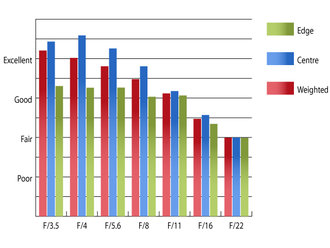 Resolution at 18mm | 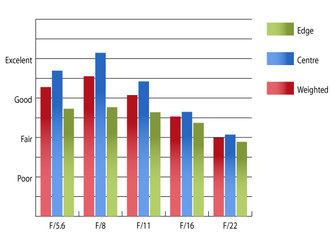 Resolution at 105mm | |
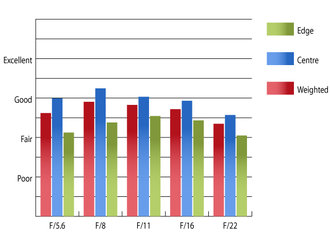 Resolution at 300mm | How to read our chartsThe blue column represents readings from the centre of the picture frame at the various apertures and the green is from the edges. Averaging them out gives the red weighted column.The scale on the left side is an indication of actual image resolution. The taller the column, the better the lens performance. Simple. For this review, the lens was tested on a Nikon D300 using Imatest. |
Levels of chromatic aberrations are an issue for this lens towards the edges of the frame, throughout the zoom range. Fringing is at its most prevalent at 105mm towards the edges of the frame, where it approaches three pixel widths in size. This level will be clearly visible along high contrast areas towards the edges of the frame.
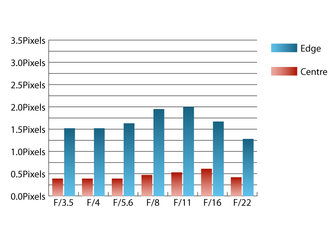 Chromatic aberration at 18mm | 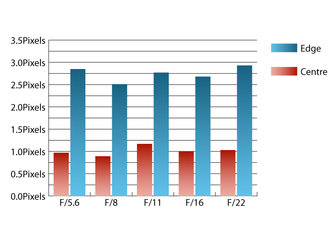 Chromatic aberration at 105mm | |
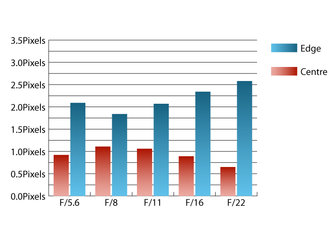 Chromatic aberration at 300mm | How to read our chartsChromatic aberration is the lens' inability to focus on the sensor or film all colours of visible light at the same point. Severe chromatic aberration gives a noticeable fringing or a halo effect around sharp edges within the picture. It can be cured in software.Apochromatic lenses have special lens elements (aspheric, extra-low dispersion etc) to minimize the problem, hence they usually cost more. For this review, the lens was tested on a Nikon D300 using Imatest. |
Falloff of illumination towards the corners of the frame is reasonably controlled for a lens of this type. At 18mm the corners are 2.19 stops darker than the image centre and at 300mm the corners are 1.4 stops darker. Visually uniform illumination is achieved with the lens stopped down to f/8 or beyond throughout the zoom range.
As is often the case with super zoom lenses, distortion is quite pronounced at both ends of the range. At 18mm 5.39% barrel distortion is present, which is a high level and at 300mm 1.89% pincushion distortion is present, which is less noticeable. Luckily the distortion patter is uniform across the frame, so any curvature should be relatively easy to correct in image editing software afterwards.
A deep, petal-shaped HB-58 hood is supplied with the lens, which does a decent job of shielding the front element from extraneous light that may cause flare or loss of contrast. Shooting into the light does result in quite a noticeable loss of contrast and the lens can be prone to flare in harsh conditions, so it's probably best to leave the hood attached.
Add your message
Login required
Please login here or if you've not registered, you can register here. Registering is safe, quick and free.
Please login here or if you've not registered, you can register here. Registering is safe, quick and free.
photodo Stats
1102 lenses
428 MTF tests
74 in-depth photodo reviews
100+ users join each day
Help the lens community by reviewing or rating a lens today via our lens search
428 MTF tests
74 in-depth photodo reviews
100+ users join each day
Help the lens community by reviewing or rating a lens today via our lens search
Latest Lens Reviews
- Chinon 28mm f/2.8 Vintage Lens Review
- Canon EF 70-200mm f/4L IS II USM Lens Review
- Samyang AF 85mm f/1.4 EF Review
- Sigma 70mm f/2.8 DG Macro Art Review
- Samyang AF 24mm f/2.8 FE Review
- Meike 50mm f/1.7 Review
- Tamron 70-210mm f/4 Di VC USD Review
- Lensbaby Burnside 35mm f/2.8 Review
- Asahi Super Takumar 50mm f/1.4 Review
- Asahi Super-Multi-Coated Takumar 135mm f/3.5 Review
